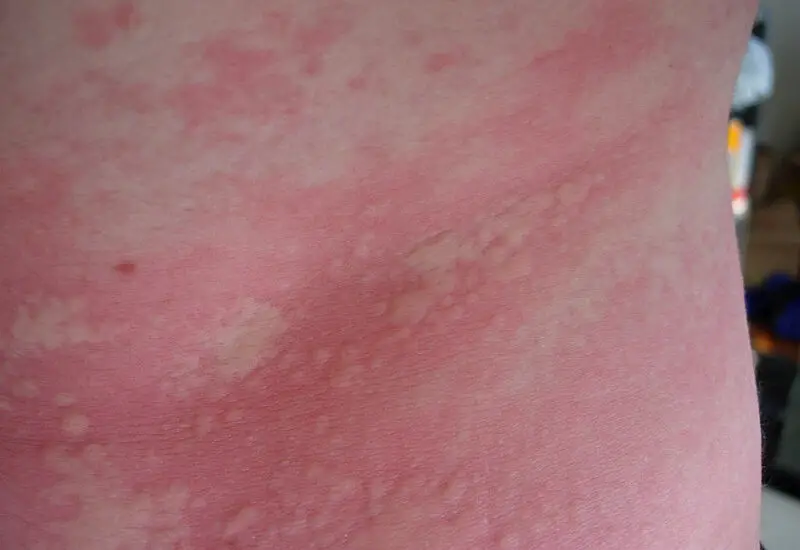If you’ve recently discovered hives on skin after exercise, it is essential to understand the root causes and preventive measures to ensure a comfortable and safe workout regime. This article aims to provide a detailed walkthrough to help you tackle this issue effectively.

Table of Contents
Understanding Hives: A Brief Overview
Hives, medically known as urticaria, are a kind of rash that appears on the skin as raised, often itchy, red, or white welts of various sizes and shapes. These welts can occur singly or they can join together to form larger areas known as plaques. They are commonly a result of the body’s reaction to certain triggers which might be allergens, heat, or stress.
Hives can appear anywhere on the body and might last for minutes or extend to several hours. They are a manifestation of an allergic reaction where histamine and other chemicals are released into the bloodstream, causing fluids to leak from blood vessels, leading to swelling and itchiness on the skin.
Reasons Behind the Appearance of Hives on Skin After Exercise
Developing hives on skin after exercise can be attributed to a variety of factors that stimulate histamine release in your body. The core reason is the increase in body temperature during and after exercise.
Histamine is a compound that the body releases in response to an allergic reaction. When you exercise, the body heats up, stimulating the release of histamine, which, in turn, triggers symptoms such as itchiness and hives.
Moreover, sweating can irritate the skin, and the friction caused by clothing can exacerbate this irritation, leading to the appearance of hives. It is a subset of a condition known as exercise-induced urticaria, which is essentially an allergic reaction to physical activity.
Recognizing the precise cause can be a stepping stone in finding appropriate preventive measures.
Factors That Can Intensify Hives on Skin After Exercise
The intensity and occurrence of hives on skin after exercise can be heightened due to several factors including the environmental conditions during the workout, the kind of clothing worn, and individual health conditions. Here, we delve into these variables in detail:
High Temperatures: Working out in high temperatures can elevate body heat quickly, promoting a rapid release of histamine which can escalate the occurrence of hives.
Unsuitable Clothing: Wearing tight, non-breathable clothing can cause irritation due to increased friction and heat, fostering the development of hives.
Diet and Medications: Consuming foods that you are allergic to, or taking certain medications before exercising can induce allergic reactions, which become intensified during physical activity, leading to hives.
History of Allergies: Individuals with a background of allergies are naturally more prone to developing hives during strenuous activities as their bodies are more reactive to triggers.
Check out these other articles…
Itchy Skin After Exercise: Why It Happens & How to Stop It
Rash on Skin After Exercise: 4 Easy Tips to Prevent & Treat
My Skin Looks Better After Exercise: Why This Happens
Bumps on Skin After Exercise: Causes, Types, & Prevention
Salt on Skin After Exercise: Why It Happens & What to Do
Preventing Hives on Skin After Exercise
Preventing hives on skin after exercise is pivotal to maintaining a healthy and comfortable workout regime. The prevention process entails addressing the potential triggers appropriately. Here are the actionable steps you can undertake:
Hydration: Adequate hydration can help in cooling the body and regulating temperature, minimizing the chances of a histamine release, hence reducing the likelihood of experiencing hives.
Proper Clothing: Opt for loose, breathable materials that do not cause irritation due to friction. Clothing made from natural fibers like cotton can be a good choice as they are less likely to irritate the skin.
You can check out this Xelky 4-5 Pack Men’s Dry Fit T Shirt listed on Amazon. It’s made from moisture-wicking fabric making it less likely to irritate your skin.
Gradual Warm-up: Embarking on a gentle warm-up routine before delving into intense workouts can help in elevating the body temperature gradually, thus avoiding a sudden spike in histamine release.
Avoid Allergens: Staying clear of foods and medications that you are allergic to before exercising can help prevent allergic reactions that can trigger hives.
Consult a Healthcare Provider: If hives frequently occur post-exercise, it is advisable to seek medical advice for personalized preventive strategies and to rule out any serious underlying conditions.


